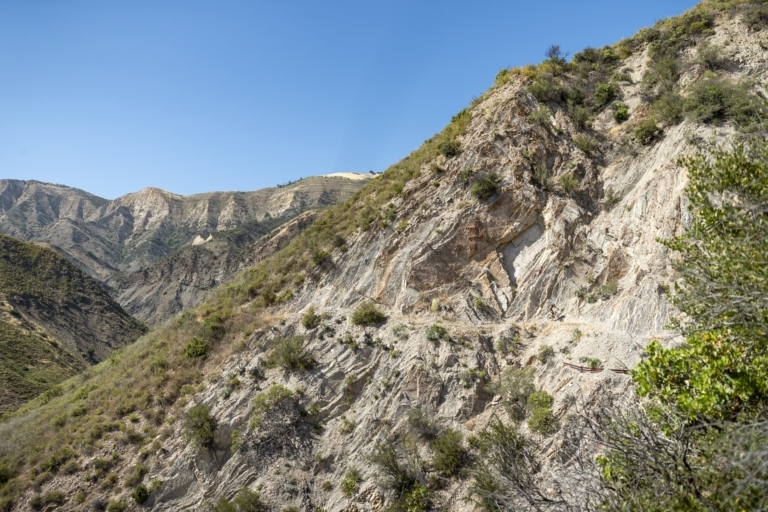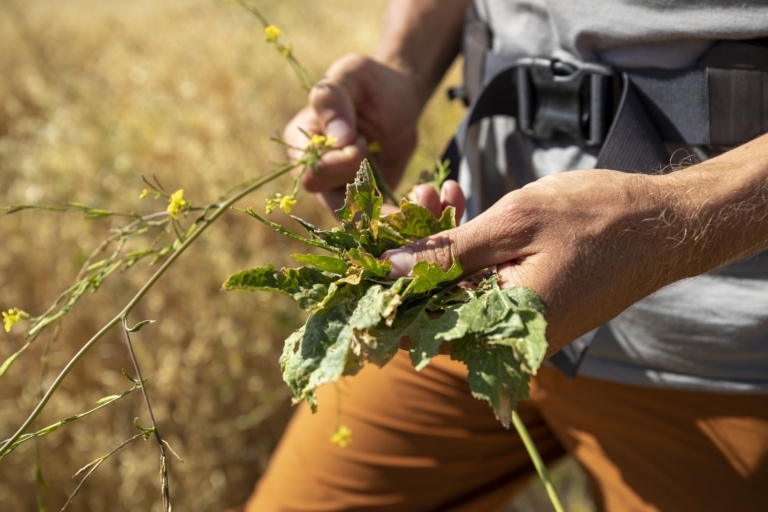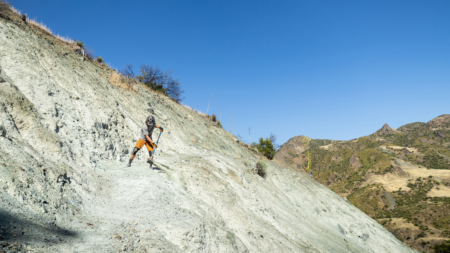Amidst the Mustard
Battling invasive species through better trailbuilding.
My tires dance along the ribbon of dirt in front of me, the bright blues and purples of lupine flowers and phacelia splashing color across the hillsides above Santa Barbara, California. Ahead, past the burnt skeletons of madrone trees and chaparral, a sea of yellow waves with the breeze. As I descend into the bloom, a cloud of pollen puffs up several feet above my head, and I am enveloped by thick stalks that grab at my brake levers and feet. In nature, some of the most harmful things are often the most beautiful. While these golden forests are stunning, the ground they hide is damaged far beyond what most of us would assume.
The trail I’m riding recently fell victim to wildfire. The native chamise scrub, sage and madrone—each colorful and scented—all burnt to the root. Without the ground cover, the soil dries out; without the native plants’ root as an anchor, that dry soil then succumbs to erosion and landslides, taking hundreds of feet of trail with it. I accepted the loss with hope for a rebirth. In a natural progression, the lupines and wildflowers would sprout and enrich the soil with nitrogen and nutrients; those minerals would feed the seed banks of thicker vegetation like chaparral and shrub trees and attract insects; and those insects and understory would attract birds and mammals. The ecosystem would begin anew. At roughly the stage when the wildflowers and birds were returning, crews loaded with 30-pound backpacks and modular tools would arrive and rebuild the trail.
But loss doesn’t always bring such a return. Back on the hillsides above Santa Barbara, there are no wildflowers when I finally pull off the trail, drop my bike, and pull a McLeod hand tool from my pack. Instead, I’m standing amidst a field of mustard: Brassica Nigra, by scientific name. The trail bursts into the open a few yards ahead—and immediately disappears under the remains of a large landslide. In areas where invasive species outcompete and replace native vegetation, these types of post-wildfire landslides can be far more destructive, even deadly. After the Thomas Fire in December 2017 and January 2018, a rainstorm caused a recently burnt slope to collapse. The resulting mudslide traveled over two miles to the beach, a 15-foot wall of trees, boulders and debris that swept through the community of Montecito at over 20 mph and killed 21 people.
While there are hundreds of invasive species that affect native ecosystems across the globe, mustard perhaps best summarizes their impact across western North America. The plant’s story in California begins in the 1700s, during the decades the Spanish priesthood constructed mission churches in their tragic efforts to evangelize Indigenous peoples. The Europeans introduced mustard in part due to its use as a spice, yet cultural literature suggests it may have also been planted to create a “golden road” between the missions. Intention aside, the yellow plant now covers hundreds of thousands of acres of California, thriving in disturbed areas such as roadsides and wildfire burn areas. And where mustard took over, climate-resilient native plants lost ground.

Learning how to identify invasive species takes time, but removing them also nurtures native plants—and, as a result, the ecosystem in general. Mustard flowers have four yellow petals and are in bloom from April until July. It often coexists with cheatgrass, another invasive plant, which is a prime example of a native-to-invasive ecosystem shift that reduces wildfire resilience. Photo: Maxwell Frank
Mustard impedes the growth of short, fire-resistant chaparral and native grasses, which slow down blazes and prevent flames from stepping up into tree canopies. These resilient plants keep the ecosystem’s fire recurrence intervals—the natural timeframe at which fires happen—at fifty to hundreds of years.
Mustard, however, readily carries flames in wind and is tall enough to bring embers into treetops; as a result, wildfires are larger, more frequent and more intense where it is present. As this cycle repeats each year, mustard spreads over more acreage—which, in turn, further increases wildfire frequency and intensity, leading to less carbon being stored in soil and plants and actively releasing greenhouse gasses. In Southern California, where mustard dominates, 100,000-plus-acre wildfires are becoming increasingly common; between 2016 and 2018, for example, just three fires—the Woolsey, Thomas and Rey—burned over 400,000 acres in three counties. That’s a fraction of the other 23.8 million acres that burned across the rest of the state in the same time span, according to the National Interagency Fire Center.
Every year, we lose more homes, trails, carbon storage and ecosystems to these little yellow flowers on tall stalks. Every year, it becomes more costly to prevent it from overrunning even more ground. Trail work plays a vital role in this battle, as invasive species are generally only combatted when they exist within a high-risk fire area or are near public trails. The US Department of Agriculture and US Forest Service are the largest entities in the fight against invasive species, but shrinking budgets and staff have left them unable to keep up.
According to the US Government Accountability Office’s 2018 trails census, there are over 200,000 miles of trails on public lands with a registered need of repair: a $900 million maintenance backlog. In the face of that deficit, nonprofits—including trail advocacy groups like the Santa Barbara-based Sage Trail Alliance (STA)—have stepped up to maintain the well-being of and access to many of these public spaces. As executive director of STA, I organize volunteer work days to do just that.

Vegetation is key to anchoring loose sediment. When wildfires occur and burn this vegetation, the soil loses cohesive elements—which, in turn, leads to landslides, like this old slide in the Los Padres National Forest. Photo: Maxwell Frank
Trail work is often seen as focused on the land’s utilitarian value—that it impacts the land for the benefit of the user, not the ecosystem—and such a mindset can lead to improper management techniques, like carelessly cutting delicate plants or not building adequate erosion control features. As trail building often entails disturbing soil, simply forgetting to properly clean seeds or plant debris off clothing or boots can spread invasive species to other areas.
This, however, doesn’t have to be the case. Many trail workers are taking a holistic approach to their craft, with as much concern for the environmental impact as the quality of the ride. This means routing trails around delicate plant species, and carefully preserving them during trail maintenance. It means taking the time to build adequate trail drainage and restoring damage from other users who went off-trail. It means removing invasive plants, using the proper technique for each particular species: mustard, for example, should be pulled out by the root, ideally before it has a chance to bloom and spread its seeds.

Pulling up mustard plants from the root is key to killing them and allowing room for native species; and, as much of a mustard plant is edible, identifying the newest leaves and yellowest flowers is key to making the best evening salad. Photo: Maxwell Frank
All are critical aspects of sustainable trail work and can increase biodiversity, reduce sedimentation in rivers and create longer-lasting—and, frankly, more fun—trails. By taking this approach, trail workers are not just building trails: they’re both restoring natural ecosystems and showing users the value of those ecosystems beyond recreation.
When we love something enough, we protect it; simply doing the least harm isn’t enough. Be it volunteering for a trail workday with your local nonprofit, helping a botanical garden identify patches of native and invasive plants in a region or contacting your representatives to act on invasive species—every action makes a difference. And that is perhaps the most valuable thing trail work provides: the opportunity to take action and protect your trails.

